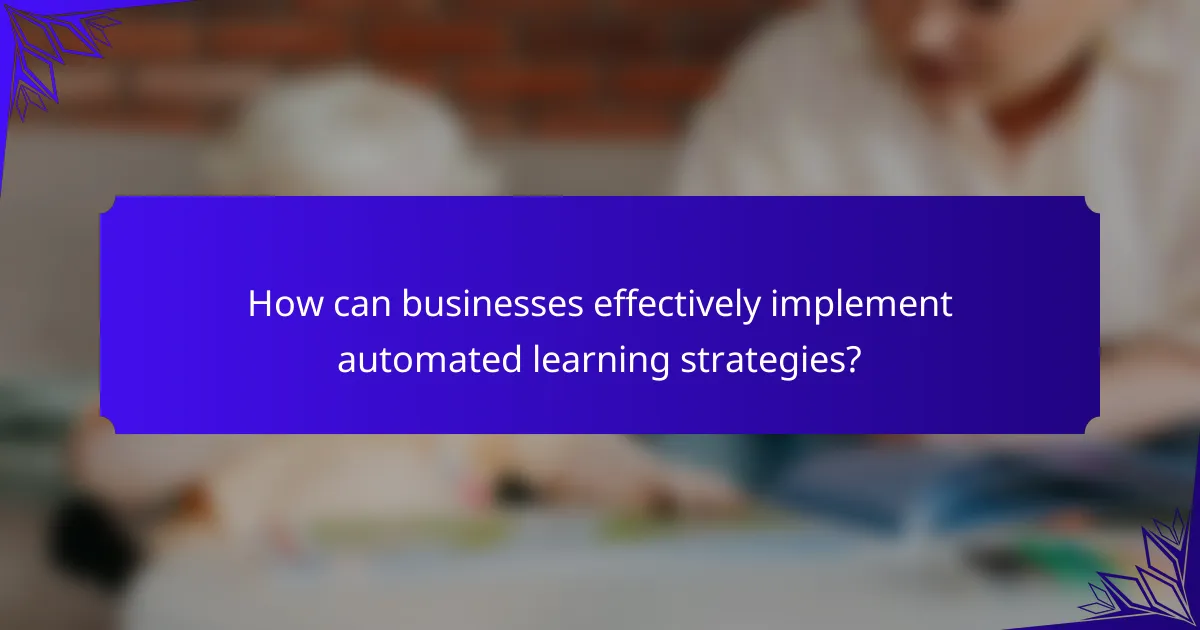Automated business ideas enhance effective learning and conditioning in today’s digital landscape. Key solutions include adaptive learning platforms, gamified training applications, and AI-driven tutoring systems. These innovations improve engagement, retention, and personalization in educational experiences. Implementing advanced technologies and establishing clear objectives are crucial for maximizing the impact of automated learning strategies.

What are the foundational automated business ideas for effective learning and conditioning?
Automated business ideas for effective learning and conditioning include adaptive learning platforms, gamified training applications, AI-driven tutoring systems, personalized learning management systems, and virtual reality training environments. These solutions enhance engagement and retention, catering to diverse learning styles and needs.
Adaptive learning platforms tailor content based on individual progress, improving knowledge retention. Gamified training applications use game mechanics to motivate learners, increasing participation. AI-driven tutoring systems provide personalized feedback, enhancing understanding. Personalized learning management systems adjust to user preferences, optimizing learning paths. Virtual reality training environments offer immersive experiences, reinforcing practical skills effectively.
How can AI-powered platforms enhance personalized learning experiences?
AI-powered platforms enhance personalized learning experiences by tailoring content to individual needs. They analyze user data to adapt learning paths, ensuring relevant material is presented. This customization increases engagement and retention rates. Furthermore, these platforms leverage machine learning algorithms to predict learning preferences, optimizing the educational journey. By continuously refining their approaches based on user interactions, they provide a unique attribute of real-time feedback, fostering a more effective learning environment.
What are the key features of AI-driven learning management systems?
AI-driven learning management systems feature personalized learning paths, real-time analytics, automated assessments, and adaptive content delivery. These systems enhance engagement and improve learning outcomes through tailored experiences. Key attributes include scalability, integration capabilities, and user-friendly interfaces. The unique advantage lies in their ability to utilize machine learning algorithms for continuous improvement.
What role do chatbots play in modern educational environments?
Chatbots enhance modern educational environments by providing instant support, personalized learning experiences, and efficient administrative assistance. They facilitate student engagement through interactive communication, allowing learners to receive immediate feedback and resources tailored to their needs. Additionally, chatbots can streamline administrative tasks, freeing educators to focus on teaching. This integration of technology fosters a more effective learning atmosphere, adapting to diverse educational requirements.
How can chatbots provide real-time feedback to learners?
Chatbots can provide real-time feedback to learners by analyzing their responses and offering instant suggestions. This immediate interaction enhances engagement and supports personalized learning experiences. By utilizing machine learning algorithms, chatbots adapt to individual learning styles, ensuring tailored guidance. For instance, if a learner struggles with a concept, the chatbot can provide additional resources or explanations, promoting better understanding. This dynamic feedback loop fosters a more effective learning environment, crucial in today’s digital landscape.
What unique automated tools support behaviour conditioning in digital spaces?
Automated tools like learning management systems and AI-driven feedback platforms enhance behaviour conditioning in digital spaces. These tools provide personalized learning experiences, adapt to user responses, and utilize data analytics to track progress. For instance, gamification elements in platforms can motivate users by rewarding achievements, reinforcing desired behaviours effectively.
How do gamification elements influence learning retention?
Gamification elements significantly enhance learning retention by increasing engagement and motivation. Features like points, badges, and leaderboards create a competitive environment that encourages continued participation. This dynamic fosters a deeper connection with the material, leading to improved memory and application of knowledge. Additionally, gamification can provide immediate feedback, allowing learners to recognize their progress and adjust their strategies accordingly. Studies indicate that learners exposed to gamified environments retain information up to 30% better than traditional methods.
What are the benefits of using automated assessments in education?
Automated assessments in education enhance efficiency, personalization, and data-driven insights. They provide immediate feedback, enabling students to identify strengths and weaknesses. These assessments also streamline administrative tasks, allowing educators to focus on teaching. Furthermore, they adapt to individual learning paces, fostering a more inclusive environment.
How can automated assessments adapt to individual learning paces?
Automated assessments can adapt to individual learning paces by utilizing data-driven algorithms that analyze learner performance in real-time. These systems adjust the difficulty level, pacing, and content delivery based on the learner’s progress and engagement metrics. This personalized approach enhances retention and motivation, leading to more effective learning outcomes. For instance, adaptive learning platforms can provide instant feedback and modify assessments to align with each student’s unique needs, ensuring that learning is both efficient and tailored.

What unique attributes differentiate successful automated learning businesses?
Successful automated learning businesses stand out due to their unique attributes such as adaptability, scalability, and user-centric design. Adaptability allows these businesses to respond quickly to changing educational needs and technologies. Scalability ensures that they can grow and serve a larger audience without compromising quality. User-centric design focuses on creating intuitive interfaces that enhance the learning experience. These attributes collectively contribute to sustained engagement and effectiveness in digital learning environments.
How does data analytics drive improvement in automated learning systems?
Data analytics enhances automated learning systems by providing actionable insights that refine educational strategies. It identifies learning patterns, optimizes content delivery, and personalizes user experiences. For instance, analytics can track student engagement metrics, allowing educators to adjust curricula in real-time. As a result, learning outcomes improve significantly, fostering a more effective digital learning environment.
What metrics are essential for evaluating learning outcomes?
To evaluate learning outcomes effectively, focus on metrics such as engagement, retention, and application of knowledge. These metrics provide insights into the effectiveness of automated business ideas in enhancing learning. Engagement metrics assess user interaction with content, while retention metrics measure how well learners remember information over time. Application metrics evaluate the practical use of learned skills in real-world scenarios, ensuring that learning translates into actionable outcomes.
What innovative technologies are transforming conditioning practices?
Automated business ideas are revolutionizing conditioning practices through innovative technologies such as artificial intelligence, machine learning, and adaptive learning platforms. These technologies personalize learning experiences, enhance engagement, and improve outcomes. For instance, AI-driven analytics can track progress and identify areas for improvement, while adaptive platforms adjust content based on user performance. Additionally, virtual and augmented reality offer immersive training environments that facilitate experiential learning. These advancements not only streamline the conditioning process but also provide scalable solutions for diverse learning needs.
How can virtual reality enhance experiential learning?
Virtual reality enhances experiential learning by providing immersive environments that engage users deeply. This technology allows learners to practice real-world scenarios safely, improving retention and skill application. For example, VR simulations in training programs can replicate complex situations, enabling learners to experiment without real-world consequences. As a result, virtual reality fosters active participation and critical thinking, making learning more effective and memorable.
What are the rare attributes of leading automated learning platforms?
Leading automated learning platforms exhibit rare attributes that enhance user engagement and effectiveness. These include adaptive learning algorithms that personalize content based on individual performance, advanced analytics for tracking learner progress, and seamless integration with various digital tools. Additionally, they often feature interactive simulations that provide immersive learning experiences, enabling practical application of concepts. Another rare attribute is the use of AI-driven feedback mechanisms that offer real-time insights, fostering continuous improvement in learning outcomes.
How do these platforms incorporate social learning features?
Automated business platforms enhance social learning by integrating collaborative tools, feedback mechanisms, and shared resources. These features promote interaction among users, facilitating knowledge exchange and peer support. For instance, platforms often include discussion forums, group projects, and real-time feedback systems, which nurture a community-driven learning environment. This approach not only improves engagement but also leverages diverse perspectives, enriching the overall learning experience.

How can businesses effectively implement automated learning strategies?
Businesses can effectively implement automated learning strategies by integrating advanced technologies and fostering a culture of continuous improvement. Utilizing machine learning algorithms allows for personalized learning experiences, adapting content to individual user needs. Data analytics can identify knowledge gaps, enabling targeted training interventions.
Moreover, incorporating feedback loops ensures that learning systems evolve based on user interactions. For instance, automated assessments can provide real-time insights into learner progress, facilitating timely adjustments. Investing in user-friendly platforms enhances engagement and retention, making learning more accessible.
Finally, establishing clear objectives and measurable outcomes is crucial for evaluating the effectiveness of these automated strategies. By aligning learning goals with business objectives, organizations can maximize the impact of their automated learning initiatives.
What are the best practices for integrating automation in educational frameworks?
Integrating automation in educational frameworks enhances efficiency and engagement. Best practices include aligning automation with learning objectives, utilizing adaptive learning technologies, and ensuring user-friendly interfaces. Regularly assess the effectiveness of automated tools to optimize learning outcomes. Foster collaboration among educators to share insights and experiences with automation. Prioritize data privacy and security to build trust in automated systems.
What common challenges arise during implementation, and how can they be addressed?
Common challenges during implementation of automated business ideas include resistance to change, lack of technical skills, and integration issues. Addressing these challenges involves providing training, fostering a culture of innovation, and ensuring seamless technology integration. Engaging stakeholders early can also mitigate resistance and enhance acceptance.
What optimization tips can enhance automated learning experiences?
Utilizing optimization techniques can significantly enhance automated learning experiences. Focus on personalization, adaptive learning paths, and real-time feedback to improve engagement and retention. Integrating data analytics allows for tailored content delivery, ensuring that learners receive relevant information. Additionally, leveraging gamification elements can motivate users and create a more interactive environment.
What common mistakes should be avoided when adopting automated solutions?
To successfully adopt automated solutions, avoid common mistakes such as inadequate planning, neglecting employee training, and failing to integrate systems. These errors can hinder productivity and lead to wasted resources. Ensure alignment between automation goals and business objectives. Prioritize a clear strategy and ongoing support to maximize effectiveness.
How can businesses stay ahead in the evolving landscape of automated learning?
Businesses can stay ahead in the evolving landscape of automated learning by embracing innovative technologies and adaptive strategies. Leveraging artificial intelligence enables personalized learning experiences, enhancing employee engagement and retention.
Investing in data analytics allows businesses to track learning outcomes and adjust programs in real time, ensuring relevance and effectiveness. Implementing collaborative tools fosters a culture of continuous improvement, where employees can share insights and learn from each other.
Moreover, integrating automation into training processes reduces administrative burdens, freeing up resources for strategic initiatives. By focusing on these areas, businesses can maintain a competitive edge and foster a skilled workforce ready for future challenges.
What emerging trends should be monitored for future opportunities?
Emerging trends in automated business ideas focus on personalized learning, AI-driven analytics, and adaptive conditioning methods. These innovations enhance user engagement and improve educational outcomes. Monitoring advancements in machine learning algorithms and virtual reality applications will reveal future opportunities in effective learning environments.


